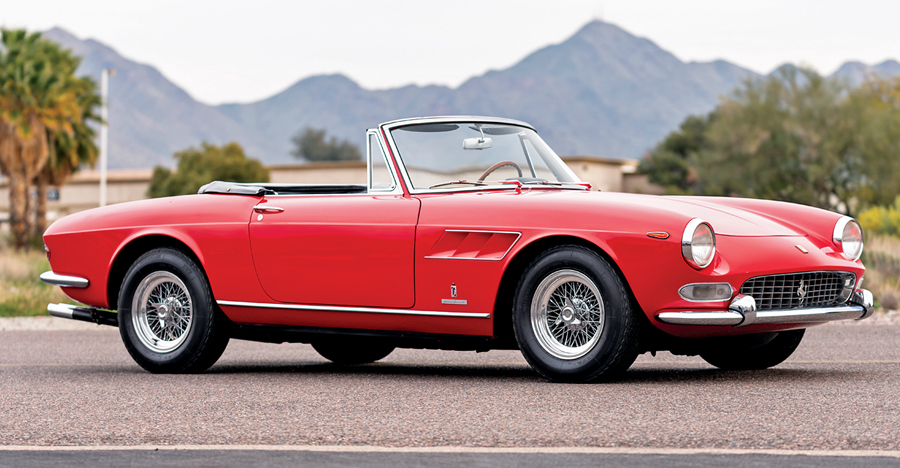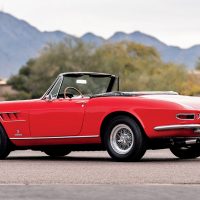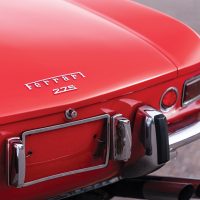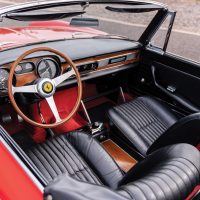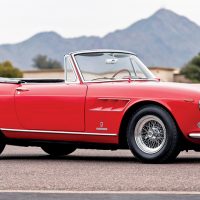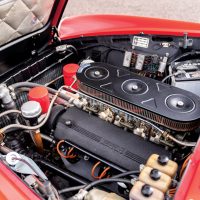- The fourth of only 200 examples built.
- Displayed on the Ferrari Stand at the 1965 Brussels Motor Show.
- First owned by noted Ferrari enthusiast Donald Andrews.
- Presented in original colors and retains matching-numbers engine.
- Documented by Ferrari historian Marcel Massini.
SCM Analysis
Detailing
| Vehicle: | 1965 Ferrari 275 GTS |
| Years Produced: | 1965–66 |
| Number Produced: | 200 |
| Original List Price: | $14,500 |
| SCM Valuation: | $1,730,000 |
| Distributor Caps: | $350 each |
| Chassis Number Location: | Front frame tube |
| Engine Number Location: | Right rear side of the engine |
| Club Info: | Ferrari Club of America, Ferrari Owners Club |
| Website: | http://www.ferrariclubofamerica.org |
| Alternatives: | 1964–65 Aston Martin DB5 DHC, 1967–72 Intermeccanica Italia, 1964–67 Jaguar XKE |
| Investment Grade: | B |
This car, Lot 26, sold for $1,325,000, including buyer’s premium, at Gooding & Company’s Amelia Island, FL, auction on March 8, 2019.
“Click! Key on, Click! Fuel pump, tick-tick-tick-tick-tick-tick-tick-tick-tick-tick … tick. Starter, rowrowrowrowrow, WHOOM!
“The first time you start a Ferrari in the morning is always just like the first time ever. One never gets used to that first blast of noise, that combination of carburetors sucking cubic yards of air, 24 valves rattling to life, 12 pistons oscillating up and down, and four large exhaust pipes coughing out half-burned fuel and blue smoke, and a droning throb.”
So goes the description of starting a 275 GTS, as chronicled in the October 1965 issue of Car and Drivermagazine.
I’ve done that procedure thousands of times, and that paragraph perfectly describes the dance of starting a 12-cylinder Ferrari with Weber carburetors. All that’s missing is the couple stabs of the gas pedal before twisting the key — and then soaking in the wonderful noises the engine makes as it explodes to life.
We shouldn’t miss how the classic wood dash fascia and steering wheel give a classic feel to the otherwise-modern GTS.
The 275 GTS is a drivers’ car that rewards your skill with sounds, smells and sensations.
We should note the sure feel of the clutch and the butter-smooth shifting of the transmission. Finally, I’d throw in how putting your foot to the floor of a 275 GTS, shifting, hitting the gas again — and trying to wring all the performance out of the 260-hp GTS is more satisfying than scaring yourself silly while nailing the newest mega-power Ferraris.
Following two legends
1964 saw the introduction of Ferrari’s 275 GTB and 275 GTS. The pair were an update to the 250 GT LWB Tour de France and the 250 GT Spyder California.
The 275 GTS was the open-top car replacing the California Spyder for sporty drives. The 275 nomenclature announces that the new models received an additional 25 cc of displacement per cylinder, but that was just the start of the improvements.
The 275 GTB’s engine was rated at the same 280 hp as the late 250 engines, but the extra 300 cc gave the 275 more torque than the 250s. Ferrari tuned the GTS engine to 260 hp, giving GTS drivers more flexibility and smoothness than raw power. In this car, 260 horsepower proved plenty for spirited driving.
Enzo Ferrari believed in dependability over innovation.
Other manufacturers were often first to pioneer new technology, and Ferrari was slow to follow.
The 275 saw the adoption of a rear transaxle, independent rear suspension, rack-and-pinion steering, and disc brakes on a production Ferrari. These innovations were a big step into the future — one that paid off in the press and in the showroom.
Wonderful history
Our subject car is a bit famous in South Florida.
It was displayed at the 1965 Brussels Auto Show before becoming part of U.S. importer Luigi Chinetti’s inventory. Chinetti sold the car to Don Andrews.
Andrews was a Ferrari pioneer — and a respected exotic-car enthusiast and salesman. Andrews was also the father of the Coppa Bella Macchina, a rigorous Ferrari Club of America event that judges the mechanical condition of a Ferrari.
Ferrari as an automobile manufacturer was just 18 years in business when Andrews bought this Ferrari. His car was about the 3,400th production Ferrari produced — and one of the very first 275 GTSs. It was a big deal.
Andrews passed this car to another South Floridian in 1969, and it passed to another owner in about 1984. The third owner traded it on a boat.
My employer, Ed Waterman/Motorcar Gallery, purchased the 275 from the boat dealer. It was then sold to Beat Christenson, a prominent Swiss classic-car dealer. Ferrari historian Marcel Massini documented it going to Japan from Switzerland before coming back to the U.S. in 2004.
On the market
Time and travel have been kind to chassis 06805.
Gooding’s pre-sale estimate was $1,300,000–$1,600,000. The $1,325,000 sale broke the low estimate, but it was hardly a sale to brag about.
High market for the 275 GTS — as well for many other collector cars — was 2015.
A January 2015 sale of $2,365,000 is the highest recorded 275 GTS sale in the SCM Platinum Auction Database. In 2016, $2,050,000 was the top sale.
By 2017, the top number had slipped to $1,700,000, but a 2018 sale of $1,760,000 showed resilience in the market.
What’s going on?
Not long ago, it looked like most early Ferraris were in the million-dollar club. If this car couldn’t hit mid-estimate, something is amiss.
A 275 GTS is a low-production, 2-passenger, open-top, 12-cylinder classic Ferrari. Collector cars don’t get much more blue chip than that. This 48,500 mile-example should have been a good catch for Ferrari collectors. So what’s up?
Perhaps the explanation comes from Sports Car Market Letter’s February 1995 issue, where a 1965 Ferrari 275 GTS was profiled on p. 25 (we were a lot smaller back then).
The unnamed writer — perhaps Publisher Martin — noted that the sale price of $114,400 was quite a drop from the Sports Car Market Letter’s Price Guide of $135,000 to $165,000.
The author wrote: “275 GTSs are a good buy in the $125,000 (range), being an attractive, relatively modern car that can be enjoyed on today’s highways.”
Maybe being disappointed at a sale of a car that is up 1,040% in 24 years is missing the big picture.
Enzo Ferrari didn’t build the 275 GTS to be an investment, and Don Andrews didn’t buy this car to make money. Andrews bought it to drive one of the best cars on the planet.
Andrews paid his money to hear the “click, tick-tick-tick, rowrowrow, varoom.” He paid to be the first one on the block with a transaxle Ferrari. I knew Don, and I suspect the experience was worth every penny it cost him.
Appreciation was never a factor in Andrews’ decision.
There’s no other business where someone walks into a showroom asking for a product they can “use a little bit and sell and make money,” yet I’m asked that once a week.
Cars are not supposed to be investments. They should be bought for enjoyment, and if they increase in value, you’re lucky.
Maybe it’s time to get back to the basics and buy what we like instead of what we think might be the next winner. ♦
(Introductory description courtesy of Gooding & Company.)
